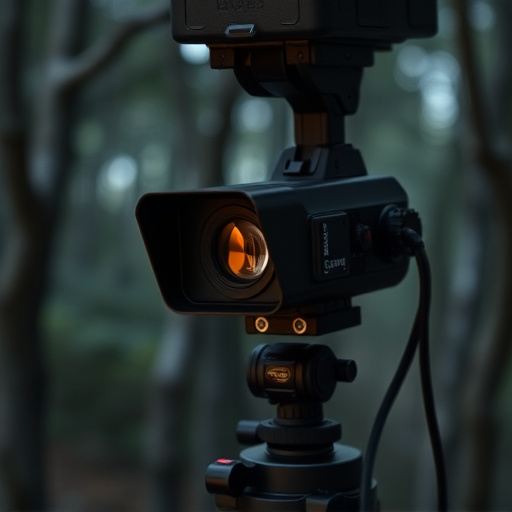Nighttime glint detection is crucial for spy camera effectiveness in low-light conditions, challenging manufacturers to balance power management with high-resolution footage. Modern advancements use advanced sensors, coatings, and algorithms to improve battery life and detect hidden cameras faster and more accurately. When comparing Battery Life Spy Camera Comparison models, key factors include resolution, field of view, motion detection, and undetected footage capture, ensuring optimal covert surveillance operations.
In the realm of covert surveillance, detecting glints from camera lenses at night is a delicate art. This article delves into the intricacies of nighttime glint detection, exploring both traditional methods and modern spy camera technologies. We dissect the challenges posed by battery life considerations, offering insights into how contemporary devices stack up in terms of performance and power efficiency. By understanding these advancements, users can make informed choices for their covert operations, ensuring optimal stealth and data capture.
- Understanding Nighttime Glint: The Basics
- Traditional Methods for Detection
- Battery Life Considerations in Spy Cameras
- Comparative Analysis: Modern Spy Camera Technologies
Understanding Nighttime Glint: The Basics
Nighttime glint detection is a critical aspect of security and surveillance systems, especially when dealing with battery-powered spy cameras. In low-light conditions, reflective surfaces like windows or shiny objects can cause glare, affecting the camera’s image quality and compromising the entire system’s effectiveness. This phenomenon, often referred to as ‘glint’ or ‘reflections,’ presents a unique challenge for covert surveillance equipment, particularly when operators are focused on preserving battery life in remote or hard-to-reach locations.
The challenge lies in balancing the need for clear, high-resolution footage during nighttime hours while managing power consumption to extend battery life. Spy camera manufacturers address this by employing advanced sensors and processing techniques. A thorough understanding of glint behavior and its impact on image quality is essential when comparing different models. For instance, some cameras use specialized glass or coating to minimize reflections, while others implement advanced software algorithms to reduce the effect post-capture. In the context of a Battery Life Spy Camera Comparison, evaluating these features becomes crucial for professionals seeking reliable, efficient surveillance solutions.
Traditional Methods for Detection
In the past, detecting hidden camera lenses—often referred to as spy cameras—relied on manual, time-consuming methods. These traditional techniques involved careful observation and a keen eye for subtle glints or reflections in low-light conditions. With the evolution of technology, however, battery life and efficient detection have become paramount. Today’s advanced methods leverage specialized equipment and software capable of analyzing even the faintest visual cues, ensuring faster and more accurate identification of spy cameras in various settings. This shift towards automated systems offers a significant advantage over manual inspections, especially when dealing with intricate or hard-to-reach areas, ultimately enhancing security measures through comprehensive comparisons of available tools.
Battery Life Considerations in Spy Cameras
In the realm of spy cameras, battery life is a critical factor that often goes unnoticed but significantly impacts their overall performance, especially during extended night-time operations. When comparing different spy camera models, one must consider the power consumption and the subsequent battery life to ensure continuous surveillance without interruption. These tiny yet powerful devices are designed to operate discreetly, often in challenging environments, making energy efficiency a key consideration.
A comprehensive spy camera should offer a balance between high-quality video capture, advanced features, and prolonged battery lifespan. In low-light conditions, sensors tend to consume more power, leading to faster drain on the battery. Therefore, manufacturers focus on optimizing components and implementing energy-saving measures to extend the duration between charges or replaceable battery cycles. This is particularly important for users who require covert monitoring over an extended period, ensuring that their spy camera remains operational without requiring frequent recharging.
Comparative Analysis: Modern Spy Camera Technologies
Modern spy camera technologies have seen significant advancements, offering more sophisticated and discreet options than ever before. One notable area of interest is the integration of advanced sensors and image processing capabilities that enable better low-light performance. In terms of battery life, compact spy cameras now boast impressive longevity, often utilizing efficient power management systems to extend operational duration between charges.
When comparing different models, factors like resolution, field of view, and motion detection capabilities play pivotal roles in determining their suitability for various surveillance needs. Additionally, the ability to capture high-quality footage undetected is crucial, which is why manufacturers are continually refining design elements like infrared LEDs and privacy-focused features. A detailed Battery Life Spy Camera Comparison reveals how these innovations cater to diverse user requirements, ensuring effective and efficient covert operations.
In the realm of nighttime surveillance, detecting camera lens glints is a game-changer. This article has explored various methods, from traditional techniques to modern spy camera technologies. As we’ve seen, battery life considerations are crucial in these devices, with modern sensors offering improved efficiency. Through a comparative analysis, it’s evident that advanced spy camera systems now provide enhanced glint detection capabilities without compromising battery longevity. These innovations underscore the evolving landscape of nocturnal surveillance technology.
